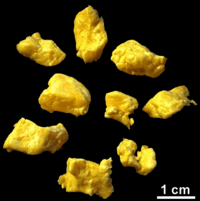Curd
Curds are a dairy product obtained by coagulating milk in a process called curdling. The coagulation can be caused by adding rennet or any edible acidic substance such as lemon juice or vinegar, and then allowing it to sit. The increased acidity causes the milk proteins (casein) to tangle into solid masses, or curds. Milk that has been left to sour (raw milk alone or pasteurized milk with added lactic acid bacteria) will also naturally produce curds, and sour milk cheeses are produced this way. Producing cheese curds is one of the first steps in cheesemaking; the curds are pressed and drained to varying amounts for different styles of cheese and different secondary agents (molds for blue cheeses, etc.) are introduced before the desired aging finishes the cheese. The remaining liquid, which contains only whey proteins, is the whey. In cow's milk, 80 percent of the proteins are caseins.
Uses
Curd products vary by region and include cottage cheese, curd cheese (both curdled by bacteria and sometimes also rennet), farmer cheese, pot cheese, queso blanco, and paneer. The word can also refer to a non-dairy substance of similar appearance or consistency, though in these cases a modifier or the word curdled is generally used.
In England, curds produced from the use of rennet are referred to as junket, with true curds and whey only occurring from the natural separation of milk due to its environment (temperature, acidity).
Cheese curds, drained of the whey and served without further processing or aging, are popular in some French-speaking regions of Canada, such as Quebec, parts of Ontario, and Atlantic Canada. In Quebec, eastern Ontario and the eastern provinces such as New Brunswick, cheese curds are popularly served with french fries and gravy as poutine.
Curds are also typical of some Germanic-descent regions such as historic Waterloo County in Ontario.[1] In some parts of the Midwestern U.S., especially in Wisconsin, they are breaded and fried, or are eaten straight.
In Turkey, curds are called keş and are very commonly used as an aphrodisiac and for breakfast served on fried bread and are also eaten with macaroni in the provinces of Bolu and Zonguldak.
In Mexico, the chongos zamoranos is a dessert prepared with milk curdled with sugar and cinnamon.
Albanian gjiza is made by boiling whey for about 15 minutes and adding vinegar or lemon. The derivative is drained 3 to 4 times with a napkin or piece of cloth and salted to taste. Gjiza can be served immediately or refrigerated for a couple of days.
Formation

Lactobacillus is a genus of bacteria which can convert sugars into lactic acid by means of fermentation. Milk contains a sugar called lactose, a disaccharide (compound sugar) made by the glycosidic bonding between glucose and galactose (monosaccharides). When pasteurized milk is heated to a temperature of 30-40 °C, or even at room temperature or refrigerator temperature, and a small amount of old curd or whey added to it, the lactobacillus in that curd or whey sample starts to grow. These convert the lactose into lactic acid, which imparts the sour taste to curd. Raw milk naturally contains lactobacillus
See also
- Aarts, Mongolian fermented curd, eaten as a dried snack or reconstituted as a hot beverage
- Buffalo curd, traditionally made thick curd for dessert
- Coalhada, Brazilian curd
- Curd snack, a snack popular in the Baltic States
- Kurt or Qurut, central Asian cheese curd
- List of dairy products
- Ostkaka, Swedish style cheese cake, some call it a Swedish National dish
- Paskha, a Russian Easter dessert made of quark
- Ricotta
- Skyr, Icelandic curd
- Tofu, the coagulated product from soy milk, from eastern and south-eastern Asian countries
- Túró Rudi, a Hungarian chocolate bar with curd
- Urdă, a Balkans fresh white cheese made from whey.
References
External links
- Food and Agriculture Organization of the United Nations
- A fresh look at fine cheese, audio tour of Canada’s best cheese curds.
- Mrs Beeton,
